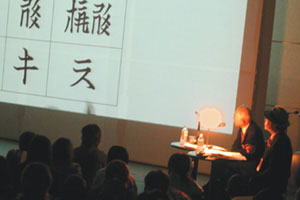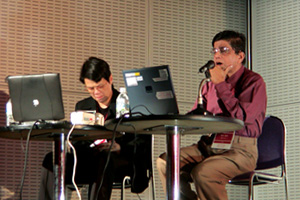|
|
 |
 |
 |
| Tatsuo Nishida (Japan), Katsumi Asaba (Japan) |
 |
Writing through time
This is a lecture about the essence and development of scripts, given
by linguistic expert Tatsuo Nishida (Japan) and hosted by Katsumi Asaba
(Japan). Nishida has written several books about hieroglyphs and writing
systems. He begins by telling us that there are still many "uncoded" writing
systems left on earth. In his research in China he has recorded and analyzed
several of these "uncoded" scripts. He also notes that in his
travels, he has realized that Japan a rare culture for using so many
different types of script simultaneously (Katakana, Hiragana, Kanji,
an even some Latin script). He takes us from the origins of Asian scripts,
the pictograph, through a variety of scripts that are descended from
them, Xia, Tompa, and Kanji. Scripts are designed for appreciation and
for linguistics, Nishida says. He recognizes that artists also create
new ways of using script for the sake of art. Picasso painting a glyph
of a bull on glass, and the painting of Jackson Pollock are both examples
of art that takes from the knowledge of script, they suggest. Although
the true origins of script are hard to say with certainty, Nishida walks
us through a theoretical history of Asian scripts. By showing a number
of clear images comparing different characters, he helps us understand
how these forms may have been developed. Nishida and Asaba conclude by
saying that young designers will be well served by learning more about
various scripts, as writing can overcome time and space to communicate.(NR)
|
 |
 |
 |
 |
 |
| R.K. Joshi (India), Esther Liu (Hong Kong) |
 |
Asian scripts go digital
In just under two hours, Professor R.K. Joshi and Esther Liu introduced
us to Indian and Chinese scripts, and delineated some concerns in bringing
these ancient writing systems into the digital age. Both are extremely
complex and based on handwriting and/or carving. They are also at the
mercy of both historical and political forces and suffering from an incompatibility
with technology in its present state.
Professor Joshi's presentation focused on the formation of Indian scripts,
which are phonetic, not ideo- or pictographic. He pointed out that scripts
were created to pass on information and wisdom: mantras, prayers, rituals.
In Indian scripts, consonants are the body, and vowels the soul. The
way vowels are added to consonants in the written language allows for
12,000 combinations. This complexity has made both hot type and digital
reproduction problematic.Å@Professor Joshi concluded with a poem: one/
by/ one/ I/ buried/ them/ beyond/ the/ page/ now/ I/ read/ empty/ blank/
space.
Ms. Liu presented fascinating research into the existence, history and
future of Chinese typography and typographers, a project prompted by
a question from Kohei Sugiura: Does Chinese typography exist in the Chinese
language? She interviewed 11 men and one woman typographer and found
out that it does, but the profession is still not clearly defined, well
paid, or efficient. The typographers come from crafts and calligraphy,
and face an Herculean task. Simplification of the characters is an ongoing
project, and still only 20-30 words can be created in a full day's work,
at a cost of $5.00/word. A bright spot: a typography competition produced
superb new fonts, and may help inspire the next generation. (MH)
|
 |
 |
 |
Writer:Kosuke Ikehata/Norimitsu Korekata/Junko Sakamoto/Nobuko
Shimuta/Naoko Hasegawa/Osamu Hisanaga/Sakurako Muto/Naho Yoshioka/Helmut Langer/Maggie Hohle/Nicole Rechia/Trysh Wahlig/Gitte Waldman/Robert Zolna
Photographer:Yoshimitsu Asai/Yasuhiko Katsuta/Fumihiko Mizutani |
 |
|

